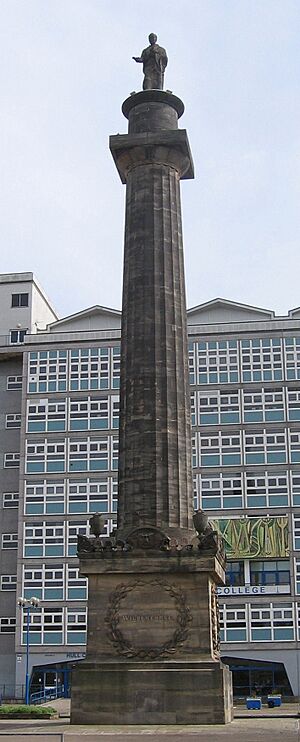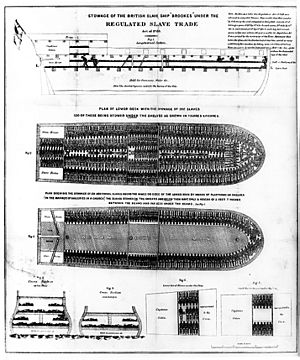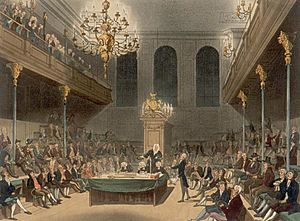William Wilberforce facts for kids
Quick facts for kids
William Wilberforce
|
|
|---|---|

William Wilberforce
by Karl Anton Hickel, c. 1794 |
|
| Member of Parliament | |
| In office 31 October 1780 – February 1825 |
|
| Preceded by | David Hartley |
| Succeeded by | Arthur Gough-Calthorpe |
| Constituency |
|
| Personal details | |
| Born | 24 August 1759 Kingston upon Hull, East Riding of Yorkshire, England |
| Died | 29 July 1833 (aged 73) Belgravia, London, England |
| Resting place | Westminster Abbey |
| Political party | Independent |
| Spouse | |
| Children | 6, including Robert, Samuel and Henry |
| Alma mater | St John's College, Cambridge |
| Signature | |
| Venerated in | Anglicanism |
| Feast | 30 July |
William Wilberforce (born August 24, 1759 – died July 29, 1833) was a British politician and a leader in the fight to end the slave trade. He was born in Kingston upon Hull, England. He started his political career in 1780. He became an MP (Member of Parliament) for Yorkshire.
In 1785, Wilberforce became a committed Christian. This changed his life and made him care deeply about helping others. In 1787, he met Thomas Clarkson and other activists who wanted to stop the slave trade. They convinced him to lead the fight in Parliament.
Wilberforce became the main English abolitionist. He led the campaign against the British Slave Trade for 20 years. His hard work led to the Slave Trade Act of 1807. This law made the slave trade illegal in the British Empire.
He believed that religion, good morals, and education were very important. He supported many causes, like creating a free colony in Sierra Leone. He also helped start the Church Mission Society and the Society for the Prevention of Cruelty to Animals.
Later in his life, Wilberforce continued to fight for the complete end of slavery. He retired from Parliament in 1826 due to poor health. The Slavery Abolition Act 1833 was passed in 1833. This law ended slavery in most of the British Empire. Wilberforce died just three days after hearing the law was sure to pass. He was buried in Westminster Abbey.
Contents
William Wilberforce: A Champion for Freedom
Early Life and Education
Wilberforce was born in Hull, England, on August 24, 1759. His family was wealthy. His grandfather made money from shipping and sugar. Wilberforce House, his birthplace, is now a museum.

He was a small and often sick child. In 1767, he went to Hull Grammar School. His father died in 1768. Young William was sent to live with his aunt and uncle in London.
While living with them, he became interested in evangelical Christianity. His family was worried about these new religious ideas. They brought him back to Hull in 1771. He then went to Pocklington School.
In 1776, at age 17, Wilberforce went to St John's College, Cambridge. He was already rich, so he didn't need to study hard. He was popular and made many friends. One of his friends was William Pitt the Younger, who later became Prime Minister.
Wilberforce enjoyed social life but still passed his exams. He earned his first degree in 1781.
His Early Political Journey
Wilberforce thought about a political career while at university. His friend Pitt encouraged him. In 1780, at 21, Wilberforce was elected as an MP for Hull. He spent a lot of money to win, which was common then.
He decided to be an "independent" MP. This meant he didn't always side with one political party. He supported both Tory and Whig governments. He voted based on what he believed was right.
Wilberforce was known for his wit and singing. He was very good at public speaking. One observer said he started like a "shrimp" but grew into a "whale" when he spoke. He often supported Pitt in Parliament.
In 1783, Wilberforce, Pitt, and Edward Eliot traveled to France. They met important figures like Benjamin Franklin and Marie Antoinette. Pitt became Prime Minister in December 1783. Wilberforce was a strong supporter.
Wilberforce never sought a government job. Pitt likely knew Wilberforce preferred to remain independent. In 1784, Wilberforce was elected MP for Yorkshire.
A Life-Changing Conversion
In October 1784, Wilberforce went on a trip to Europe. This trip changed his life. He traveled with his mother, sister, and Isaac Milner, a religious scholar. They read a book about religion together.

Wilberforce had a deep religious experience. He started reading the Bible and praying daily. He decided to dedicate his life to serving God. This made him very self-critical, but he remained cheerful.
At the time, strong religious belief was sometimes seen as strange. Wilberforce wondered if he should stay in politics. He asked for advice from John Newton, a famous clergyman. Both Newton and Pitt told him to stay in politics.
From then on, his faith guided his political work. He wanted to promote Christian values in public life. He was often seen as conservative. He supported traditional values and opposed radical changes.
In 1786, Wilberforce moved closer to Parliament. He tried to pass a bill to change election rules. It passed in the House of Commons but failed in the House of Lords.
Fighting the Slave Trade
The Start of the Campaign
Britain became involved in the slave trade in the 1500s. By 1783, the "triangular trade" was huge. British ships took goods to Africa, bought enslaved people, took them to the West Indies, and brought slave-grown products back to Britain. This trade made up 80% of Britain's foreign income.
British ships carried thousands of enslaved Africans across the Atlantic. This journey was called the "middle passage." Conditions were terrible, and many died. About 1.4 million out of 11 million enslaved Africans died during the voyage.
The campaign to end the slave trade began in the 1780s. The Quakers were among the first to protest. In 1783, Wilberforce met James Ramsay, a former ship's surgeon. Ramsay had seen the horrible conditions of enslaved people.
Ramsay wrote a book about the cruel treatment of enslaved people. This book helped raise public awareness. Slave owners were angry and attacked Ramsay's ideas.
In 1786, Sir Charles Middleton suggested Wilberforce take on the cause in Parliament. Wilberforce felt it was a huge task but agreed to consider it. He started reading about the slave trade.
In 1787, Thomas Clarkson visited Wilberforce. Clarkson had written an essay against the slave trade. They became partners in the fight. Clarkson gathered evidence about the slave trade.
Wilberforce was asked to lead the parliamentary campaign. He agreed, saying he would do it if no one better could be found. On May 12, 1787, he spoke with Pitt and William Grenville. Pitt urged him to act quickly. Wilberforce made his decision then.
Wilberforce felt called by God to end the slave trade. He also wanted to improve moral values in society. The anti-slavery movement helped improve the public image of evangelicals.
Early Parliamentary Action
On May 22, 1787, the first meeting of the Society for Effecting the Abolition of the Slave Trade took place. Quakers and Anglicans worked together for the first time. They decided to fight the slave trade, hoping slavery itself would eventually end. Wilberforce joined the committee later in 1791.
The society was very good at getting public support. They used new methods like lobbying, writing pamphlets, and holding public meetings. They even had a campaign logo: a kneeling slave with the words "Am I not a Man and a Brother?"
Clarkson traveled to collect evidence. Former enslaved people like Olaudah Equiano wrote books and spoke out. Hundreds of thousands of people signed petitions against the slave trade. This was the world's first major human rights campaign.
In January 1788, Wilberforce became ill. Pitt, who supported abolition, introduced a motion himself. A government investigation into the slave trade began.
On May 12, 1789, Wilberforce gave his first big speech against the slave trade. He said it was morally wrong. He described the terrible conditions on slave ships. He proposed 12 resolutions to condemn the trade.
Opponents delayed the vote by asking for more evidence. Wilberforce agreed, which some say prolonged the trade. The hearings continued into the next year. Wilberforce's house became a center for abolitionist meetings.
In April 1791, Wilberforce introduced the first bill to abolish the slave trade. But it was defeated. The French Revolution had made people more conservative. Some even suspected Wilberforce of being a radical.
This was the start of a long fight. Wilberforce never gave up. He was supported by friends known as the Clapham Sect. They were evangelicals who lived near Clapham, London. They were committed to Christian values and fighting slavery.
In 1792, Wilberforce and his friends helped set up a free colony in Sierra Leone. They wanted to show that freed Africans could build a successful society. The project faced many challenges but became a symbol of anti-slavery.
On April 2, 1792, Wilberforce tried again to pass an abolition bill. It was a famous debate. Henry Dundas suggested a gradual abolition. This compromise passed.
War and Continued Efforts
In 1793, another vote to abolish the slave trade failed. War broke out with France, which made politicians focus on national defense. Public support for abolition decreased. The anti-slavery society stopped meeting for a while.
Despite this, Wilberforce kept introducing abolition bills throughout the 1790s. In the early 1800s, public interest in abolition grew again. Clarkson returned to work. New members joined the society.
In June 1804, Wilberforce's bill passed the House of Commons. But it was too late to pass the House of Lords that year. It was defeated when reintroduced in 1805.
The Final Push for Abolition
After Pitt died in 1806, Wilberforce worked more with the Whigs. Many abolitionists joined the government. A new plan was suggested: ban British ships from supplying slaves to French colonies. This was clever because many British ships were secretly doing this.
The new bill, the Foreign Slave Trade Bill, passed quickly in May 1806. Wilberforce then wrote a 400-page book arguing for abolition. In the autumn of 1806, a general election brought more abolitionist MPs into Parliament.
Prime Minister Lord Grenville decided to introduce the main Abolition Bill in the House of Lords first. It passed there by a large margin. On February 23, 1807, the bill was brought to the House of Commons.
Wilberforce was honored as the bill passed by a vote of 283 to 16. The Slave Trade Act 1807 became law on March 25, 1807. This was a huge victory.
Personal Life
William Wilberforce married Barbara Ann Spooner in 1797. He was 37, and she was 20. They had a quick romance and were married within weeks. They were very devoted to each other. Barbara supported him, especially when his health declined.
They had six children in less than ten years. Wilberforce was a loving father. He enjoyed spending time and playing with his children.
Other Important Work
Political and Social Reforms
Wilberforce held many conservative views. He believed society should change through Christian values and better morals. He was against radical changes. Some critics, like William Cobbett, said he ignored problems in Britain while fighting for slaves abroad.
He supported laws that limited public meetings. He also opposed workers' rights to form unions. He even approved of laws that punished protesters after the 1819 Peterloo Massacre.

Wilberforce also had conservative views on women. He didn't approve of women organizing anti-slavery groups. He initially opposed allowing Catholics to become MPs, but later changed his mind.
However, he also supported progressive causes. He worked to improve conditions for chimney-sweeps and textile workers. He helped with prison reform and tried to limit the death penalty. He believed education was key to helping the poor. He supported Hannah More's Sunday schools for poor children.
Wilberforce helped found the world's first animal welfare organization. It was called the Society for the Prevention of Cruelty to Animals. He was also against dueling.
He was very generous with his money and time. He believed wealthy people should give to those in need. He gave away thousands of pounds each year. He also helped many people with advice and support.
Promoting Christian Values
Wilberforce was a strong supporter of the evangelical part of the Church of England. He believed that a stronger church and more personal faith would create a better society. He wanted to make religion more important in public and private life.
In 1797, he published a book called A Practical View. It explained Christian teachings and called for a revival of faith. The book was very popular and sold many copies.
Wilberforce supported missionary work in Britain and other countries. He helped found the Church Mission Society. He also worked to convert Jewish immigrants to Christianity.
He was concerned about the lack of Christian teaching in India. In 1813, he successfully campaigned for changes to the East India Company's charter. This allowed Christian teachers and chaplains to go to India. He criticized the company's rule and aspects of Hinduism.
Moral Improvements
Wilberforce was worried about what he saw as declining morals in British society. He believed this was as important as ending the slave trade. He worked to stop "profaneness" and "disorderly practices."
He helped create the Society for the Suppression of Vice. This group aimed to prosecute those who broke moral laws. Some critics said the society focused more on the poor's sins than the rich's.
However, Wilberforce's efforts did help improve British morals and social responsibility over time. This paved the way for changes in society during the Victorian era.
Ending Slavery Completely
Even after the slave trade ended, slavery itself continued. Conditions for enslaved people did not improve much. Wilberforce worked with the African Institution to make sure the abolition law was enforced. He also pushed other countries to end the slave trade.
In 1812, Wilberforce's health worsened. He resigned his seat for Yorkshire and became an MP for Bramber. This seat had fewer duties, giving him more time for his family and causes.
After the Napoleonic Wars, Wilberforce focused on ending slavery itself. He introduced bills to register slaves. This would help detect illegal slave imports. He also began to speak out against slavery publicly.
By 1820, his eyesight was failing. He decided to limit his public activities. In 1821, he asked Thomas Fowell Buxton to lead the anti-slavery campaign in the House of Commons. Wilberforce remained a key figurehead.
In 1823, the Society for the Mitigation and Gradual Abolition of Slavery was founded. Wilberforce published a document called "Appeal to the Religion, Justice and Humanity..." He argued that slavery was a national crime that must end. Parliament did not agree quickly.
Buxton moved for gradual emancipation in Parliament. Wilberforce made his last speeches in the House of Commons in 1824.
Last Years and Legacy
Wilberforce's health continued to decline. In 1825, he resigned from Parliament. He left the campaign in the hands of others. Thomas Clarkson continued to travel and advocate. Buxton led the fight in Parliament. Public support for immediate abolition grew stronger.

In 1826, Wilberforce moved to a smaller home. He faced financial difficulties due to his son's bad investments. He continued to support the anti-slavery cause.
In 1833, Wilberforce's health got much worse. He gave his final anti-slavery speech in April. The Whig government introduced the Bill for the Abolition of Slavery. On July 26, 1833, Wilberforce heard that the bill was sure to pass. He died three days later, on July 29.
One month later, the Slavery Abolition Act passed. It abolished slavery in most of the British Empire. Nearly 800,000 enslaved Africans were freed.
Funeral and Memorials
Wilberforce had wanted a simple burial. But members of Parliament insisted he be buried in Westminster Abbey. He was buried near his friend William Pitt. Many MPs and members of the public attended his funeral.

After his death, his sons wrote a biography about him. They focused on his role in abolition. Later historians have recognized the important partnership between Wilberforce and Clarkson. Both were essential for ending the slave trade.
Wilberforce is seen as a Christian hero. He is remembered for putting his faith into action. He helped change political and social attitudes. He promoted ideas of social responsibility.
Many places honor Wilberforce. A statue of him stands in Westminster Abbey. In his hometown of Hull, the Wilberforce Monument was built. His birthplace, Wilberforce House, is now Britain's first slavery museum.
Wilberforce University in Ohio, USA, is named after him. It was the first university owned by African-American people. The film Amazing Grace (2006) tells his story.
See also
 In Spanish: William Wilberforce para niños
In Spanish: William Wilberforce para niños
- List of civil rights leaders
- The Wilberforce Institute for the study of Slavery and Emancipation
- The Wilberforce Society




